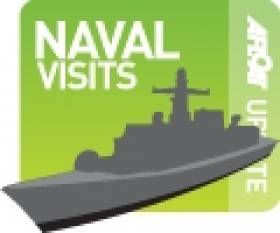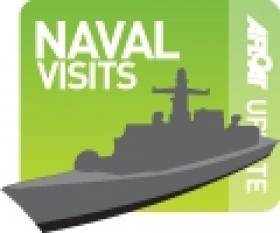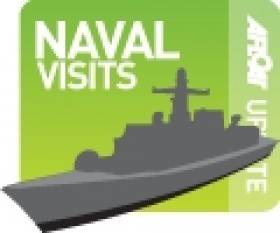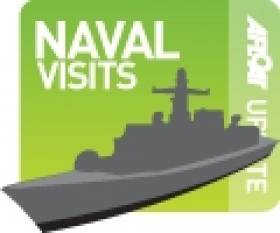Displaying items by tag: Royal Navy
#RoyalNavy - As well to yesterday's inaugural Stena Explorer (HSS) highspeed sea service sailing this year from Holyhead to Dun Laoghaire Harbour, a Royal Navy inshore fast-patrol training boat followed in her wake, writes Jehan Ashmore.
HMS Express (P163) speed across the Irish Sea at some 17 knots from the Anglesea port while the HSS fast-ferrycraft surged ahead at almost 24 knots during her first crossing of the seasonal-only operated service of five months duration until 9 September.
The Archer P2000 class 20m patrol boat follows the visit of one of her 14 sisters, HMS Exploit (P127) which too made a call to Dublin Bay ports, firstly at the Poolbeg Yacht & Boat Club's marina in Ringsend and last week to Dun Laoghaire Harbour Marina.
The primary function of the P2000 class which form the First Patrol Boat Squadron is supporting the University Royal Naval Units (URNU) in addition they contribute to other wide range roles.
The URNU is based at HMS Cambria, a Royal Navy Reserve establishment near Cardiff and some of the patrol boats are based at Penarth Marina in Cardiff Bay.
Royal Navy Patrol Training Boats to Visit Dublin Bay Ports
#PatrolBoats – Two Royal Navy P2000 'Archer' class inshore fast-patrol and training boats will have visited both Dublin Bay ports by the middle of next week, writes Jehan Ashmore.
HMS Exploit (P127) which recently paid a visit to Dublin Port at the Poolbeg Yacht & Boat Club's marina was also followed by a short-hop across the bay to Dun Laoghaire Harbour Marina where she departed yesterday evening.
She had set originally off from Penarth Marina near Cardiff and made en route call to Ireland via Milford Haven. A sister HMS Express (P163) is due to Dublin Port in several days time.
Both 20m boats as previously reported on Afloat.ie called to Dun Laoghaire Marina a year ago.The pair as previously mentioned belong to the Archer P2000 class numbering 14 vessels and which form the First Patrol Boat Squadron.
Their primary function is supporting the University Royal Naval Units (URNU) in addition they contribute to other wide range roles. The URNU is based at HMS Cambria, a Royal Navy Reserve establishment near the Welsh capital.
#Philippines – The Royal Navy's helicopter-carrier HMS Illustrious (R06) which visited Dublin Port in April is heading for the Philippines to bolster efforts to help those in the wake of Typhoon Haiyan.
UK Prime Minister David Cameron yesterday ordered that the former aircraft-carrier which was on a counter-piracy patrol off Somalia to break-off and make the 4,500-mile journey to the Far East.
HMS Illustrious has around nine days to reach the stricken nations central islands. She follows destroyer HMS Daring which is just around a day away from the worst-affected area and ready to begin her relief mission.
In addition Mr. Cameron has pledged £10m in aid and dispatching two RAF C17 Globemaster transporter aircraft which will also support the relief operation, codenamed Operation Patwi.
HMS Darling had departed Singapore on a mercy dash across the South China Sea and Pacific. The 8,000 tons destroyer was five months into a nine-month global deployment that included an international naval exercise Bersama Lima.
The Portsmouth-based Type 45 destroyer has a large flight deck to accommodate helicopters (up to the size of a Chinook), which will be vital for this latest disaster relief role. The destroyer's multi-purpose role demonstrates the global capability in providing humanitarian aid after natural disasters.
She is the first of the six Type 45 destroyers, each costing £1bn and they are the most advanced warships the Royal Navy has ever had built. She was launched at BAE Systems Scotstoun shipyard on the Clyde, one of three Scottish facilities to remain as centres of naval shipbuilding in the UK, following widespread cut to jobs.
BAE Systems to Cut 1,775 Jobs at UK Shipyards
#UKyardClosure - Shipyard workers at BAE Systems, numbering 1,775 jobs are to lose their jobs in Scotland and England and end shipbuilding altogether at Portsmouth, writes BBC News.
The firm said 940 staff posts and 170 agency workers will go at the Portsmouth site, which will retain repairs and maintenance work.
Some 835 jobs will be lost at yards in Govan and Scotstoun, on the River Clyde in Glasgow, and Rosyth in Fife and at the firm's Filton office, near Bristol.
The cuts follow a drop in work after the end of aircraft carriers work.
BAE Systems employs a total of 4,400 people in shipbuilding in the UK, 1,200 in Portsmouth and 3,200 across Govan, Scotstoun, Rosyth and Filton.
The company said it had made the cuts because of a "significant" drop in demand.
The defence contractor and the Ministry of Defence (MoD) have together announced measures which they hope will offset the effect of the job cuts.
Among the plans are more than £100m of investment to expand the dockyard at Portsmouth.
Three new ocean-going Offshore Patrol Vessels for the Royal Navy will also be built at BAE's Govan and Scotstoun yards in Glasgow.
This could help sustain shipbuilding at the yards until work is due to begin on the Type 26 Global Combat ships.
BAE, which heads a consortium that includes Babcock and Thales UK, said it had agreed changes to the Queen Elizabeth-class aircraft carrier contract it signed with the MoD in 2009.
This would see the consortium's fee move to a 50-50 risk share arrangement which would provide greater cost performance incentives.
A statement released by BAE Systems said: "Under these proposals, shipbuilding operations at Portsmouth will cease in the second half of 2014.
For much more details on this major historic development in the British shipbuilding sector, BBC News Glasgow and West Scotland reports.
Royal Navy Fast Patrol Boat Visits Howth Harbour
#RoyalNavy - Howth Harbour, synonymous with Asgard's pivotal gun-running role of 99 years ago, is in the present-day a port of call for HMS Charger (P292) a Royal Navy 'Archer' class fast patrol boat, writes Jehan Ashmore.
The patrol cadet trainee boat is powered by two Rolls-Royce turbo engines. Her fleet-mates have previously called to the major Irish Sea fishing harbour with its marina of the Howth Yacht Club.
Another momentous historic event, this time by HMS Charger, took place earlier this summer, as she became the first Royal Navy vessel to visit the quays of Wexford since Irish Independence. The diminutively sized vessel measuring a mere 20m long on a beam of 5.9m was taking part in the second John Barry Maritime Festival.
HMS Archer is based at the Royal Naval Headquarters (Merseyside) and attached to the Liverpool University Royal Naval Unit. She has five full time Royal Navy crew, and sails with a Royal Navy Reserve training officer and a maximum complement of 12 students.
She was commissioned in 1988 and is one of 14 'Archer' class boats that represent the smallest vessels in the Royal Navy fleet.
Her next port of call is scheduled to be Cork city-centre quays with a berth at the North Custom House Quay.
#royalnavy – In 1953, the Royal Navy's helicopter search and rescue service was founded, making 2013 its 60th anniversary of saving lives at sea and on land.
And it's looking for help from people around the UK and Ireland.
To celebrate this significant diamond milestone, an appeal is being made to both former Royal Navy search and rescue crew members, as well as those who have been rescued by one of the Senior Service helicopters, to come forward with their stories.
These tales will help form the back bone of an on-going project to bring together all aspects of the service within a comprehensive archive – preserving the history for years to come.
Over the six decades, Royal Navy search and rescue has, at some time, operated out of a total of 11 bases, eight of them now either decommissioned or no longer in RN hands. They are:
• RNAS Eglinton/HMS Gannet near Londonderry, Northern Ireland
• RNAS Ford/HMS Peregrine near Littlehampton in Sussex
• RNAS Brawdy/HMS Goldcrest in SW Wales near Haverfordwest
• RNAS Gosport/HMS Siskin in Hampshire
• RNAS Lee-on-Solent/HMS Daedalus in Hampshire
• RNAS Portland/HMS Osprey in Portland Harbour, Dorset
• RNAS Culdrose/HMS Seahawk in Helston, Cornwall
• RNAS Yeovilton/HMS Heron in Somerset
• RNAS Lossiemouth/HMS Fulmar near Elgin in north east Scotland
• RNAS Anthorn/HMS Nuthatch on the Solway Coast in Cumbria
• RNAS Prestwick/HMS Gannet in Ayrshire
Of the above, Royal Naval Air Station Culdrose and HMS Gannet in Prestwick continue to operate this lifesaving service – together carrying out well over 500 sorties a year to people in distress.
HMS Seahawk has operated the full range of naval search and rescue helicopters – the Westland Dragonfly, Whirlwind, Wessex and Sea King – during a period from 1953 to the present day. The base's range extends up into Devon, throughout Cornwall, down to the Isles of Scilly and 200 nautical miles out to sea across the Western Approaches.
Personnel from the unit have been involved across the West Country and far out to sea in some of the UK's most difficult and memorable rescues, including the 1979 Fastnet Race disaster, the 1989 rescue of the crew of the MV Muree, the Boscastle Floods of 2004 and the grounding of MSC Napoli in 2007. In all these cases, and many others besides, members of 771 Naval Air Squadron were decorated for their life-saving efforts.
HMS Gannet, as first 819 Naval Air Squadron and later Gannet SAR Flight have both used variations of the familiar Sea King, which still patrols our skies today. HMS Gannet is the only unit to have operated search and rescue from two locations – HMS Gannet was previously based at RNAS Eglinton in Northern Ireland until the base closed in 1959.
As with Culdrose, rescuers from HMS Gannet have been decorated with operational honours for their part in some notable rescues, including that of three climbers in a blizzard from the notorious Tower Ridge on Ben Nevis in 2007, six crew from the stricken MV Riverdance ferry in Blackpool in 2008, a climber from an avalanche in Glencoe in 2009 and, most recently, a climber with an ankle injury from Argyll's Beinn Sgulaird in 2011. Three of these were carried out under cover of darkness and all were in the grip of horrendous weather.
Were you rescued in the last 60 years by one of the Royal Navy's helicopters? Do you know someone who was and who may like to tell their story? Or, alternatively, are you a former crew member of one of the RN search and rescue squadrons with tales to tell?
The Royal Navy would love to hear all about your memories.
If you would like to share your experiences, please email your story to [email protected] including your name and contact details, as well as when you served or were rescued. Please do not send pictures, though letting us know if you have any available would be much appreciated. Alternatively send your memories to RN SAR 60, 771 NAS, RNAS Culdrose, Helston, Cornwall, TR12 7RH.
See www.royalnavy.mod.uk/News-and-Events/Special-Events/SAR-60 for more information and to download the form.
Duke Class Frigate HMS Somerset to Make Visit
#RoyalNavy – HMS Somerset (F82) a Royal Navy Type 23 Duke Class frigate of 4,900 displacement tonnes is due to make a courtesy call to Dublin Port over the weekend, writes Jehan Ashmore.
The frigate is due to arrive early Saturday morning with her 184 strong –crew. She is one of a batch of Type 23 class frigates ordered in 1992 from the Yarrow yard in Scotstoun from where she was launched two years later.
The frigates are the core of the front-line fleet and HMS Somerset is based in her homeport of Devonport. As previously reported a sister HMS Richmond (F239) in March also made a call to the capital and more recently the rare visit of HMS Illustrious (RO6) in late April.
#AircraftCarrier – During the rare visit of the Royal Navy's HMS Illustrious (R06) to Dublin Port (PHOTO's) at the weekend, the last serving 'Invincible' class aircraft-carrier was given a Gathering welcome with a showering of green light, writes Jehan Ashmore.
The 22,000 displacement tons former aircraft-carrier which currently serves in the role as a High Readiness Helicopter and Commando Carrier, had called to the capital having completed Exercise Joint Warrior, a multi-national event involving several navies, off the coast of Scotland.
The 35 year old vessel which berthed at Alexandra Basin, was floodlit in green (as it happens, aptly on her starboard side) from lamps laid alongside Ocean Pier.
The special lighting effects were created by the Worshipful Company of Lightmongers with whom 'Lusty' as she is affectionately known by her 700 crew have a close affiliation to.
Niall Gibbons, CEO Tourism Ireland, said: "We were delighted to welcome HMS Illustrious to Ireland and are sure that the sailors on board received a wonderful Irish welcome during their stay."
During her visit, two members of the Ship's Company, Able Seaman Andrew Liston, 25, from Chesterfield and Able Seaman Aaron Canwell, 31, from Wembley, were both awarded certificates of Irish Heritage for having family ties to the country.
Another highlight of their 'Gathering' visit was a performance by Irish group, Ragus, who transformed the ship's hangar into a stage filled with traditional Irish music and dance.
HMS Illustrious was launched in 1978 from Swan Hunter on the Tyne and for most of her career spanning more than three decades the 209m long vessel had on board the famous 'Harrier' VSTOL jump-jets aircraft.
The Portsmouth based vessel is one of four Royal Navy core amphibious vessels, however she is due to pay off in 2014 and in her place are a pair of Queen Elizabeth class 65,000 tons aircraft –carriers currently under construction.
Until these newbuilds are delivered, HMS Ocean (L12) a helicopter carrier of 21,500 tons which has called to Dublin Port on previous occasions, is to replace the Lusty after completion of a £65m refit at Devonport Royal Dockyard early next year.
Yesterday HMS Illustrious departed Dublin Port as did all the other visiting navies which took part in Exercise Joint Warrior, except for the French Navy's oil replenishment tanker Marne which made an exodus this afternoon.
#Aircraft-Carrier- The Royal Navy's HMS Illustrious (RO6) which is the High Readiness Helicopter and Commando Carrier made a rare visit to Dublin Port when the 22,000 tonnes former aircraft-carrier docked at noon today, writes Jehan Ashmore.
The last of the 'Invincible' class of aircraft-carriers commissioned for the Royal Navy is in the capital as part of an international naval flotilla which are arriving at various stages today, having just completed a major multi national warfare exercise off the coast of Scotland.
Captain Martin Connell, Commanding Officer said: "We are really delighted to be visiting Dublin, especially during the period of The Gathering."
To mark her visit to Ireland during the Gathering, HMS Illustrious will be floodlit in green. Captain Connell added "we have been kindly donated some high powered green lighting. We are all looking forward to seeing the end effect."
HMS Illustrious which otherwise is known affectionately by all aboard as 'Lusty' – which used to carry 'Harrier' VSTOL jump-jet aircraft is due to pay off after 32 years sterling service in 2014 to make way for the next-generation aircraft carriers.
As previously reported on Afloat.ie, on the other side of the Irish Sea, she made a call to Liverpool in February on what was likely to be her last call to that city as part of a farewell UK tour of ports.
As regards HMS Illustrious's last call to Dublin Port, this was back in 2005 where she docked along the south quays, whereas on this occasion she is moored in Alexandra Basin, facing opposite the Poolbeg Yacht & Boat Club marina in Ringsend.
She is to remain in the port over the weekend and depart on Monday.
Royal Navy Patrol Boats Return to Dun Laoghaire Marina Adding to Mix of Non-Leisure Craft
#NavalVisits – This weekend Dun Laoghaire Marina is host again to the same pair of Royal Navy 'Archer'-P2000 class training patrol boats that had called earlier this month, writes Jehan Ashmore.
As previously reported the Cardiff based pair HMS HMS Express (P163) and HMS Exploit (P167) with a crew of five each, are used to support the University Royal Naval Units (URNU). It transpires that on the last deployment, the pair did not reach Cork Harbour due to bad weather, however the boats called to Waterford instead.
Each of the 54 tonnes boats can carry university cadets where they train at weekends and during fortnightly deployment trips which can include trips to foreign shores.
The cadets perform a variety of tasks among them fire and flood exercises and navigational skills which also involves use of the flying bridge with its greater visibility.
Such a feature is also paramount particularly for SAR duties of the RNLI lifeboats, where two lifeboats of the service were berthed nearby of the P2000 craft. Also berthed in close proximity was the Irish Revenue Commissioners 23m cutter RCC Faire, a Finnish built 71 tonnes craft which transited Dalkey Sound last Friday.
In addition the largest vessel berthed in the 820-berth marina is the 26m excursion vessel St. Bridget, operated by Dublin Bay Cruises. The 100 passenger vessel is due to start a new service this month running between the harbour's East Pier and Howth Harbour.
Finally, moored alongside the inner berths closer to the shoreline were the research vessels RV Keary belonging to the Geological Survey of Ireland and fleetmate Cosantóir Bradán, which had served a career with Inland Fisheries Ireland.






































































